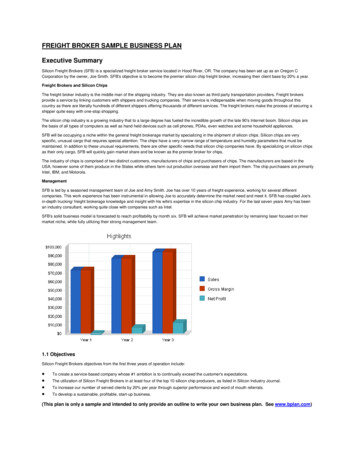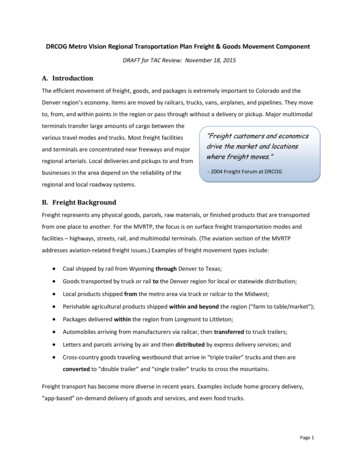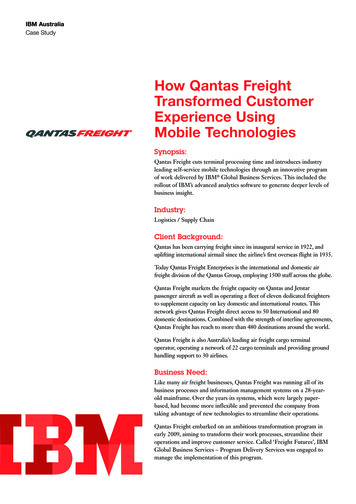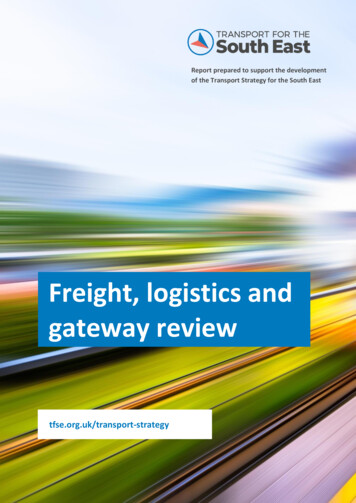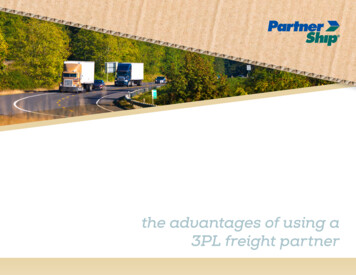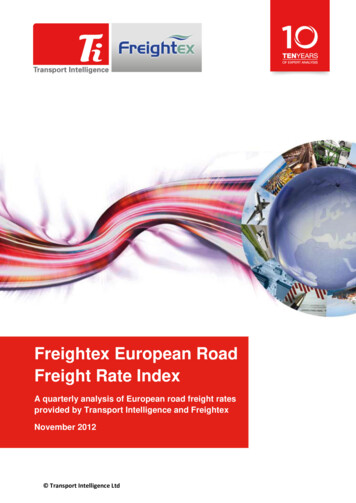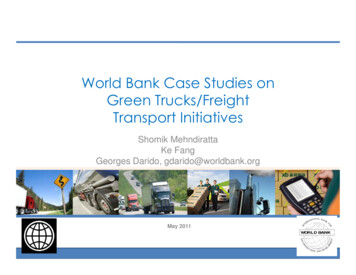
Transcription
World Bank Case Studies onGreen Trucks/FreightTransport InitiativesShomik MehndirattaKe FangGeorges Darido, gdarido@worldbank.orgMay 2011
World Bank Green Freight InitiativesCHINA CASE STUDY2
Road Freight in China Trucks account for 54% of total transport sector fuelconsumption in China. Road freight volume grew rapidly along with the fast growth ofChina’s manufactory-dominated economy.Freight Ton-KilometersKilometers (100 million)1,2001,000800Total Freight Ton-Kilometers Transported by Road inGuangdong Province(1985 – 2008)6004002000World Bank - Green Freight Transport Initiatives
Energy Efficiency Energy efficiency in the sector remains very low.o Poor fuel economy of truckso A large portion of “empty miles” Energy efficiency technologies and practices are notwell utilized, despite potential fuel savings and economicbenefits4World Bank - Green Freight Transport Initiatives
Barriers on Energy Efficiency Market failure occurs mainly because:o Trucking companies reluctant to experiment with new orunknown technologieso Lack of information and confidence on the performance,cost and availability of fuel efficiency technologies National and local governments are reluctant to take“heavy-handed” measures, worried about their impact oneconomic growth5World Bank - Green Freight Transport Initiatives
Objectives of Green Freight Initiative Aiming to address the market failure by– providing better information and better confidence in theperformance of proved energy efficiency technologies andpractices,– increasing awareness and demand for energy efficiencytechnologies, and– facilitating the increase of the technology supply inChinese market.6World Bank - Green Freight Transport Initiatives
Areas & Steps for Policy Intervention4. Modal Shift3. Improved Logistics2. Behavior & Maintenance1. Technologies7World Bank - Green Freight Transport Initiatives
The Project Development Process a tiny-sizedpilot testing8Developing aconceptualframework forcollaborationWorld Bank - Green Freight Transport InitiativesPreparation of ademonstrationproject, incl.suveys of theindustry andfinancing market
Sector situation in China Tire pressure– Most drivers only use hammer to check tire pressure– 14% of drivers check pressure less than once per week Truck loads– Empty of partially empty trucks are common– Overloading is common Many cost-effective technologies available but not yetwidely applied––––Low rolling resistance tiresAluminum wheelsAutomatic tire pressure monitoringAerodynamics: e.g. skirts or nosecone Introduction of Euro IV fuel makes emission reductiontechnologies possible9
Pilot Testing Carried out in Guangzhou, 2008-2009– Technology testing on 14 trucks in three truck fleets Tire systems Aerodynamics10World Bank - Green Freight Transport Initiatives
Pilot Testing: Tire equipment (a) Dual low rolling resistance tires: reduces rollingresistanceLoad and Inflation 830 kPa 5,000 kg455/50R 22.5RULE: For every 70 kPa underinflation is 1% penalty in fueleconomy11World Bank - Green Freight Transport Initiatives
Pilot Testing: Tire equipment (b) Aluminum wheels: reduces weight of wheel12World Bank - Green Freight Transport Initiatives
Pilot Testing: Tire equipment (c) Automatic tire pressure monitoring system: keepstire pressure more constant13World Bank - Green Freight Transport Initiatives
Pilot Testing: Aerodynamics (a) Skirts: reduce wind underneath the trailerHDPE plastic will last lifeof trailer14World Bank - Green Freight Transport Initiatives
Pilot Testing: Aerodynamics (b) Nosecone: reduces turbulence15World Bank - Green Freight Transport Initiatives
Pilot Testing: Aerodynamics (c) Gap fairing: reduces the tractor-trailer gapDistance between back ofcab and front of trailerTrailer GapWill make difference in %of savings16World Bank - Green Freight Transport Initiatives
Green Trucks Pilot Project Guangzhou3 Fleets Driver Training XingBang Co. – Tires & Monitoring, [local & Long Haul] 1.8% fuel efficiency improvement Star of City Logistics Co. – Tires, Monitoring, nose cone,Trailer Skirts, [Long Haul] 3.5% improvement Baiyun Municipal Garbage – Tires, Monitoring, [Local]up to 18% improvement
Training and Overseas Study Tour Training workshops for government staff and enterprisemanagement in Guangzhou Two-week tailor-designed training program (includingsite visits) in the US for senior officials 17 directors, chiefs, and general mangers across different governmentagencies in Guangdong, learned about: Smatway Program (US EPA) Freight Logistics (CS Robinson, Safeway,Port of Tacoma) Emissions Policy (California ResourceBoard ) Green Freight Technology & Financing(CSS) Vehicle Scrapping (Port of Seattle TruckScrapping Program)18World Bank - Green Freight Transport Initiatives
Dissemination/Communication/CollaborationGuangdong ProvincialDepartment of TransportGuangzhou Transport CommitteeWorld Bank Project ManagementOffice, GuangzhouGuangzhouEnvironmentalProtection Bureau19World Bank - Green Freight Transport Initiatives
Guangdong Demonstration Project (1) Technology Demonstration– Energy Efficiency truck technologies demonstration 1500-1800 trucks– Pilot testing of logistics operation technologies: Pilot Advanced Brokerage Information System Pilot “Drop-and-Hook” freight operations20World Bank - Green Freight Transport Initiatives
Guangdong Demonstration Project (2) Innovative Finance– Green Freight technology rebate based on the prevailing down payment rate for a truck loan– performance-based payments based on the prevailing interest rate of a truck loan– better access for SMEs to commercial finance creating quality pipeline projects for commercial banks sharing information between banks and SMEs21World Bank - Green Freight Transport Initiatives
Guangdong Demonstration Project (3) Large-scale Capacity Building––––––––22Policy researchTraining for installation and operation of technologiesTraining for government officials and enterprise managersMarketing and brandingAwareness raising and information dissemination“Green Freight Trade Fairs” and “Green Freight Submits”Driving market demand for green freight service providersEnhanced Carbon Accounting and Supply Chain EfficiencyWorld Bank - Green Freight Transport Initiatives
World Bank Green Freight InitiativesBRAZIL CASE STUDY23
Emissions from the sector will continue to growBrazil CO2 Emissions by Vehicle CategoryTrucksMinistério do Meio Ambiente, 1º inventário Nacional de Emissões Atmosféricas Por VeículosAutomotores Rodoviários, Janeiro 2011.24World Bank - Green Freight Transport Initiatives
Fuel costs compared to total costs Fuel is a very important part of truck operating costs(excluding maintenance and depreciation costs) Approximate share of total operating costs in Brazil:Tolls, 10%Insurance,20%Fuel, 40%Wages,30% In China, fuel can be as much as 59% of operating costs25
Convergence of agendas on green freight1. Logistics: efficiency, competitiveness and growthSupporting improvements in the freight and logisticssector to drive efficiency, competitiveness, and growth2. The “Green” agenda: Promoting climate change mitigation by supporting stepsto reduce the carbon intensity of the freight sector Supporting governments dealing with local air pollution Finding synergies and other co-benefits, such ascongestion management in urban areas26World Bank - Green Freight Transport Initiatives
Elements of a Market study Large share of truck fleet is quite old, mostly used byowner-operators (see next slide) Large number of “empty” truck-km due to demand andproduction imbalances and lack of an integrated network Targeting “green” strategies for a diverse sector Building blocks for a “green freight” program consideringthe fragmentation of policies Industry surveys to identify common practices,awareness of technologies, win-win conditions Working in partnership with Government, IndustryAssociations and NGOs27World Bank - Green Freight Transport Initiatives
Profile of Truck Fleet in Brazil, 2009 1.3 million trucks by engine/emissions technology andtype of ownership: 20yrs6-20 dent 3(EUROI)P2(Euro 0)P1 andOlder0World Bank - Green Freight Transport Initiatives
Green strategies: short to long-termInfrastructure Improving condition of existing roadways to reduce operatingcosts Expanding rail/waterway network to induce mode shiftsLogistics (reducing empty truck kms) Network optimization with communications equipment andnew facilities (terminals, etc.)Behavior and maintenance Driver training (eco-driving) Financing and capacity building for small operators Better regulations and enforcementTechnologies for Energy Efficiency Oldest trucks: scrappage programs Trucks in operations: incremental technology improvements,incentives for experimenting and adopting New trucks: standards, smart incentives (tax) and regulations Public-Private Partnerships and voluntary programs tomainstream technologies (e.g. SmartWay)29World Bank - Green Freight Transport Initiatives
Building Blocks to a Voluntary ProgramElements of a truck programExample of initial approachMainstream cost-effective technologiesTechnology pilotVoluntary partnership programsRegulation and enforcementEffortCostTraining for drivers and maintenancePilot carbon footprinting of supplychainForum for dialog with industryFinancial incentives (e.g. scrappage)Long-term infrastructure investments30Risk-sharing with incrementalfinancingWorld Bank - Green Freight Transport Initiatives
Creating a menu like this for Brazil31World Bank - Green Freight Transport Initiatives
Unique features of Brazilian trucks32
Technology pilot test Understand what technologies are available or are inappropriate Truck fleet made up of two or more companies Technologies to be tested:– Aerodynamic deflectors, gap fairings, and trailer skirts– Low rolling resistance tires (not super singles)– Tire pressure monitor (next generation of Rodo-ar) Experimental design, lessons learned from China pilot test:––––Recognizing daily and seasonal variables like demand, behaviorsShort-duration vs long-duration testRepresentative fleet vs. outlier fleetTraining of drivers (before/after) Monitoring and evaluation by an independent and respected localpartner33World Bank - Green Freight Transport Initiatives
Next steps Policy Dialog– Developing a constituency with government, leading companies,industry associations, NGOs– Understanding current incentives and financing mechanisms,e.g. BNDES Procaminhoneiro Dissemination– Finding partners to disseminate results from seminars with thehighest levels of government to capacity-building with truckers– Technical site visit for officials– Trade fairs– Website, materials, and videos Urban Freight Management – a growing problems in bigcities34World Bank - Green Freight Transport Initiatives
Urban Freight Management in São Paulo Area and time restrictions fortrucks Urban Freight Vehicle (VUC): sizeand performance standard Distribution hubs and logisticsplatforms Exclusive corridors and bypasses:ring road and rail Tolling/pricing? World Bank/GEF funded effort todevelop tools:– First freight origin-destinationstudy (freight flow survey)– Urban freight transport modelWorld Bank - Green Freight Transport Initiatives
Thanks for your attention Georges Darido202-473-7319gdarido@worldbank.org36World Bank - Green Freight Transport Initiatives
Road freight volume grew rapidly along with the fast growth of China's manufactory-dominated economy. 1,000 1,200 Kilometers (100 million) Total Freight Ton-Kilometers Transported by Road in Guangdong Province World Bank -Green Freight Transport Initiatives 0 200 400 600 800 Freight Ton-(1985 - 2008)
